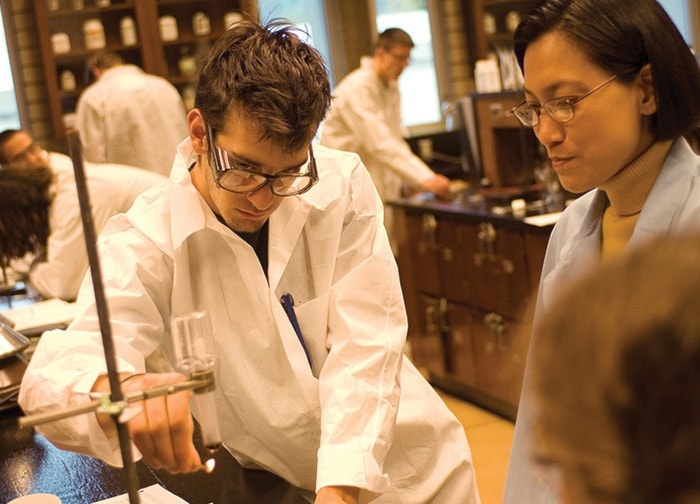A proactive solution to the rural doctor shortage in Canada is coming out of a local post-secondary institute.
After nearly two years of study and preparation, Selkirk College has launched its Rural Pre-Medicine Advanced Diploma and Associate Degree Program.
Based out of its Castlegar Campus, the program will offer students wanting to pursue a career in medicine a three-year opportunity to learn in the intimate setting of a rural college.
“Selkirk College understands rural life and the challenges of living away from urban centres,” says Selkirk President Angus Graeme. “We saw a need in this province and across the country for this type of start to a career in medicine. We are extremely pleased to be part of what could be an important piece of the solution.”
Research suggests many factors contribute to the ongoing and increasingly severe shortage of rural doctors in Canada. Medical schools and various levels of government have developed a wide range of programs and strategies to address some of these contributing factors.
Selkirk College believes much more can be done at both the undergraduate and high school levels to encourage and support talented rural and Aboriginal students who wish to become physicians.
“If their pathway towards medical school starts in a small centre, the data shows that when they graduate from medical school at an urban university they are more likely to return to a rural setting,” says Neil Coburn, Selkirk College vice president of education and students.
A rural upbringing, combined with positive undergraduate and graduate rural exposure prior to and during medical school, are two factors consistently cited in recent research as most important in determining whether a student will ultimately choose to practice in a rural environment.
Nelson physician and lead with the Rural Obstetrics Network Dr. Jeanette Boyd concurs.
“It is very important to start at the source of the rural doctor shortage,” she says. “It is well known that students from a rural background are more likely than their urban colleagues to choose a career in rural medicine. The Selkirk program has the potential to expose a greater proportion of rural students to the possibilities of a career in rural medicine and to provide them a strong foundation for the competitiveness of the medical school admission process.
Selkirk aims to give rural and Aboriginal students who face both real and perceived economic, social and educational barriers to becoming a physician a viable pathway towards becoming a physician.
Boyd sees this local option as a benefit to students in keeping their debt load down by allowing them to live at home. Students also stay close to their support systems and mentors.
Dr. Boyd says kids growing up rurally go on to make excellent rural physicians because they come to the profession with an understanding of the complexities of rural healthcare. They know innovation and resilience are required to integrate, often with their families, into a rural community.
“More importantly, they have a first hand understanding of how the social determinants such as education, isolation, employment and cultural issues can impact health. They have often insight into the complexity and breadth of skills required to be a competent rural practitioner, and the determination and ingenuity to seek out the opportunities to build these skills,” says Boyd.
The Nelson doctor says the new program also provides students with an enhanced set of skills that will increase their competency as rural healthcare providers. Non-credit course work offered, in conjunction with the Mir Centre for Peace, gives students mediation training, cultural sensitivity training, mindfulness training and contemplative practices to enrich and cultivate skills around attention and emotional balance, altruism, empathy, critical thinking and decision-making.
The college also hopes to offer directed service opportunities such as partnering with Selkirk’s BSc Nursing Program in its successful Street Nursing Initiative and the International Nursing Practice Experience in Guatemala.
“Selkirk College is perfectly positioned to offer a comprehensive pre-medicine program,” says Elizabeth Lund, Selkirk College Chemistry instructor and the originator of the program. “This is an exciting and innovative program in Canada and has garnered interest from all levels of health care. Although students can complete all of their required prerequisites at other institutions, we are offering an integrated program that, to our knowledge, is not available elsewhere in Canada.”
In creating this program, Selkirk College has worked closely with the UBC Faculty of Medicine, the Rural Coordination Centre of BC (a joint venture of the BC Medical Association, the Ministry of Health and the UBC Faculty of Medicine), Native Education College, the Interior Health Authority, Columbia Basin Trust, local physicians, nurses, nurse practitioners and other health care providers.
Students enrolled in the program will complete all of the requirements including the writing of the MCAT (Medical College Admission Test) and will be eligible to apply for entrance to the undergraduate MD program at UBC’s Faculty of Medicine.
“Entry in UBC Medicine is highly competitive and excellent students who meet all of the entrance criteria are turned down each year,” says Lund. “Any students who are not accepted into medical school after third year or choose to pursue different career paths can transfer into fourth year at a university, such as UNBC [University of Northern British Columbia], and complete a Bachelor’s degree in an alternate pathway.”
The start date of the program is Fall 2014 with an initial cohort of 24 students admitted to the program.
